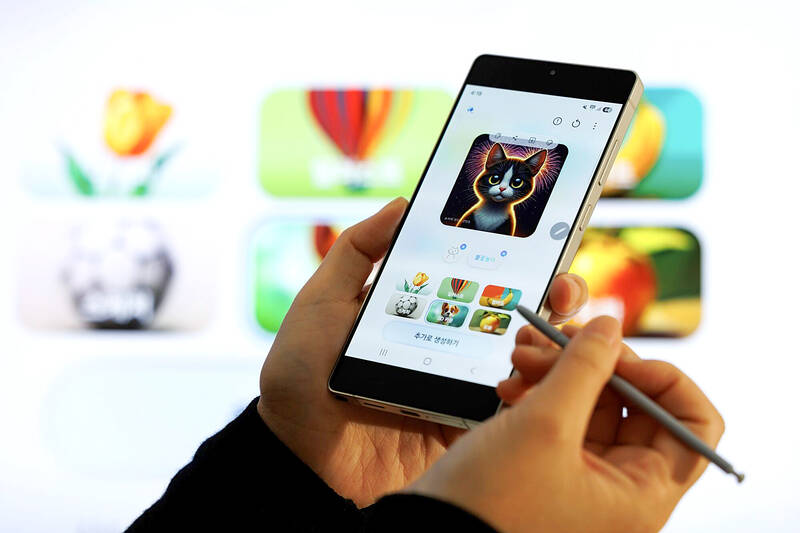Samsung Electronics Co on Wednesday unveiled its newest Galaxy S25 smartphones, powered by Qualcomm’s chips and Google’s artificial intelligence (AI) model, hoping its upgraded AI features can reinvigorate sales and fend off Apple Inc and Chinese rivals.
Samsung also previewed a thinner version of the flagship models at the end of an event in California, aiming to launch the Galaxy S25 Edge in the first half of this year ahead of Apple’s anticipated rollout of its slimmer iPhone.
Samsung was faster than Apple in launching an AI-powered smartphone, but failed to regain its crown in the global smartphone market last year, squeezed by competition with the US rival in the premium market and with Chinese firms in the lower-end segment.

Photo: Bloomberg
“We are one step ahead of the industry in terms of offering AI features. I believe we are going in the right direction,” said Park Ji-sun, the executive vice president who leads Samsung’s Language AI team.
Samsung kept the prices of its Galaxy S25 series unchanged at between US$799 and US$1,299.
The new Galaxy S25 uses Gemini offered by Alphabet’s Google as its default AI engine and features Samsung’s upgraded in-house voice assistant, Bixby, Park said.
The two tools complement each other and Bixby plays a key role at Samsung, whose products span mobile phones to TVs and home appliances, he said.
Thomas Husson, an analyst at Forrester, said that differentiating Bixby would be a challenge for Samsung.
“I don’t think there is really a killer application today that you know would convince them [consumers]: ‘OK, I’m going to buy this one because it’s an AI smartphone,’” he said.
However, AI features could create a halo effect around the Samsung brand, Husson said.
The Galaxy S25 would offer a more personalized AI experience. For example, its “Now Brief” service — which makes recommendations to users based on personalized data that is stored and processed on the phone for privacy reasons — would display a suite of customized items such as calendars, news and bedroom air temperature and carbon dioxide levels, Park said.
The phone would be able to carry out multiple tasks with a single command, such as finding upcoming sporting events and then adding them to users’ calendars.
Samsung used Qualcomm’s Snapdragon 8 Elite Mobile Platform for the entire Galaxy S25 lineup, ditching its own mobile chip Exynos, a major change of strategy for a company that previously used both to have more bargaining power with suppliers.
Using a Qualcomm chip is a setback to the South Korean firm’s chip business, which counts its mobile division as one of its major customers.
A person familiar with the matter said that Samsung is looking to use the Exynos chip in its foldable phones to be launched later this year.
“The Galaxy S25 series’ sale is important at a time when Samsung’s foldable phone sales have been stagnating in the face of challenges from Chinese companies,” said Lim Su-jeong, associate director at research firm Counterpoint.
Samsung’s preliminary fourth-quarter profit, released earlier this month, missed estimates by a large margin due to chip development costs and rising competition in the smartphone market.

Nvidia Corp CEO Jensen Huang (黃仁勳) is expected to miss the inauguration of US president-elect Donald Trump on Monday, bucking a trend among high-profile US technology leaders. Huang is visiting East Asia this week, as he typically does around the time of the Lunar New Year, a person familiar with the situation said. He has never previously attended a US presidential inauguration, said the person, who asked not to be identified, because the plans have not been announced. That makes Nvidia an exception among the most valuable technology companies, most of which are sending cofounders or CEOs to the event. That includes

TARIFF TRADE-OFF: Machinery exports to China dropped after Beijing ended its tariff reductions in June, while potential new tariffs fueled ‘front-loaded’ orders to the US The nation’s machinery exports to the US amounted to US$7.19 billion last year, surpassing the US$6.86 billion to China to become the largest export destination for the local machinery industry, the Taiwan Association of Machinery Industry (TAMI, 台灣機械公會) said in a report on Jan. 10. It came as some manufacturers brought forward or “front-loaded” US-bound shipments as required by customers ahead of potential tariffs imposed by the new US administration, the association said. During his campaign, US president-elect Donald Trump threatened tariffs of as high as 60 percent on Chinese goods and 10 percent to 20 percent on imports from other countries.

Taiwanese manufacturers have a chance to play a key role in the humanoid robot supply chain, Tongtai Machine and Tool Co (東台精機) chairman Yen Jui-hsiung (嚴瑞雄) said yesterday. That is because Taiwanese companies are capable of making key parts needed for humanoid robots to move, such as harmonic drives and planetary gearboxes, Yen said. This ability to produce these key elements could help Taiwanese manufacturers “become part of the US supply chain,” he added. Yen made the remarks a day after Nvidia Corp cofounder and chief executive officer Jensen Huang (黃仁勳) said his company and Taiwan Semiconductor Manufacturing Co (TSMC, 台積電) are jointly

United Microelectronics Corp (UMC, 聯電) expects its addressable market to grow by a low single-digit percentage this year, lower than the overall foundry industry’s 15 percent expansion and the global semiconductor industry’s 10 percent growth, the contract chipmaker said yesterday after reporting the worst profit in four-and-a-half years in the fourth quarter of last year. Growth would be fueled by demand for artificial intelligence (AI) servers, a moderate recovery in consumer electronics and an increase in semiconductor content, UMC said. “UMC’s goal is to outgrow our addressable market while maintaining our structural profitability,” UMC copresident Jason Wang (王石) told an online earnings